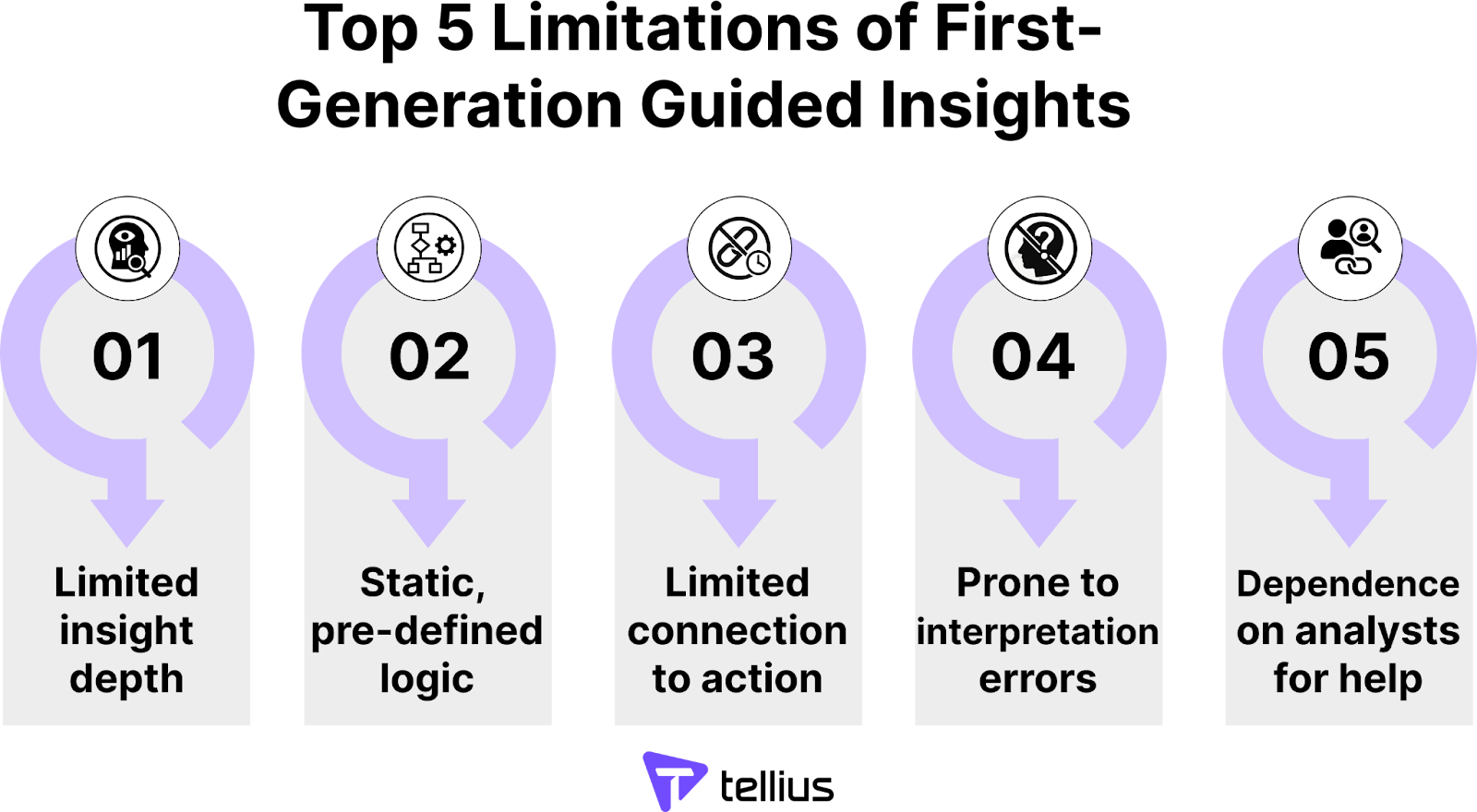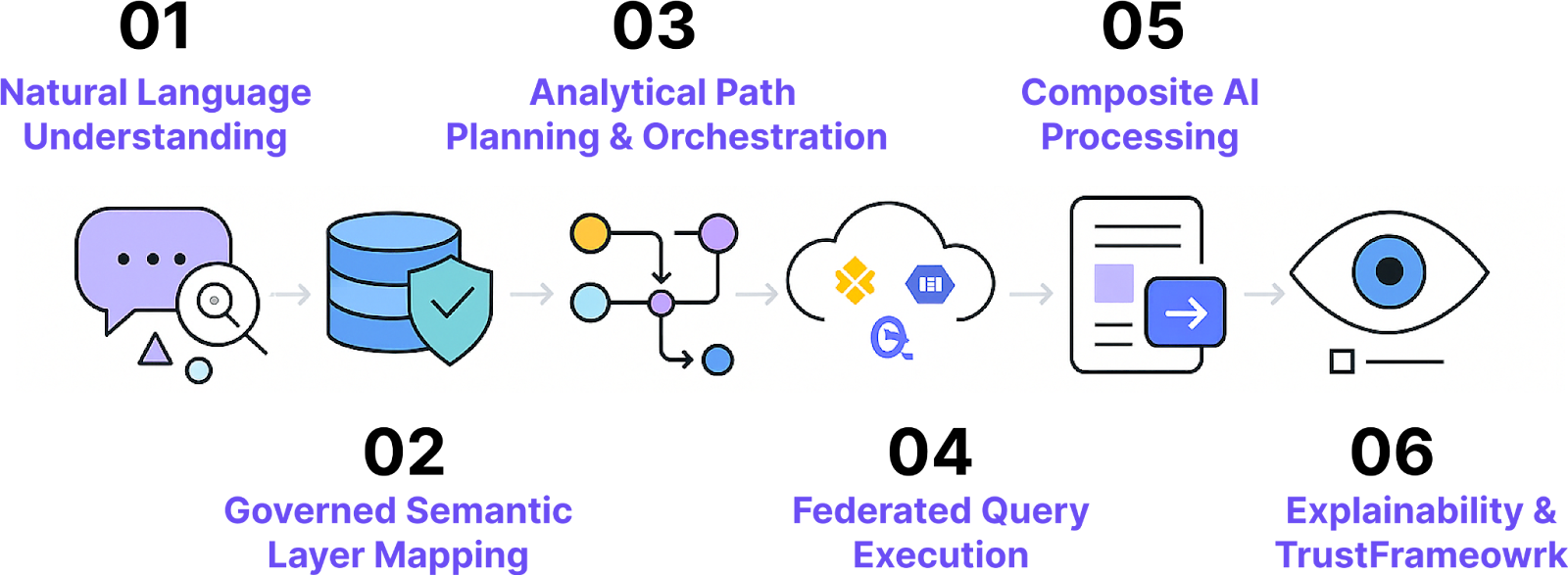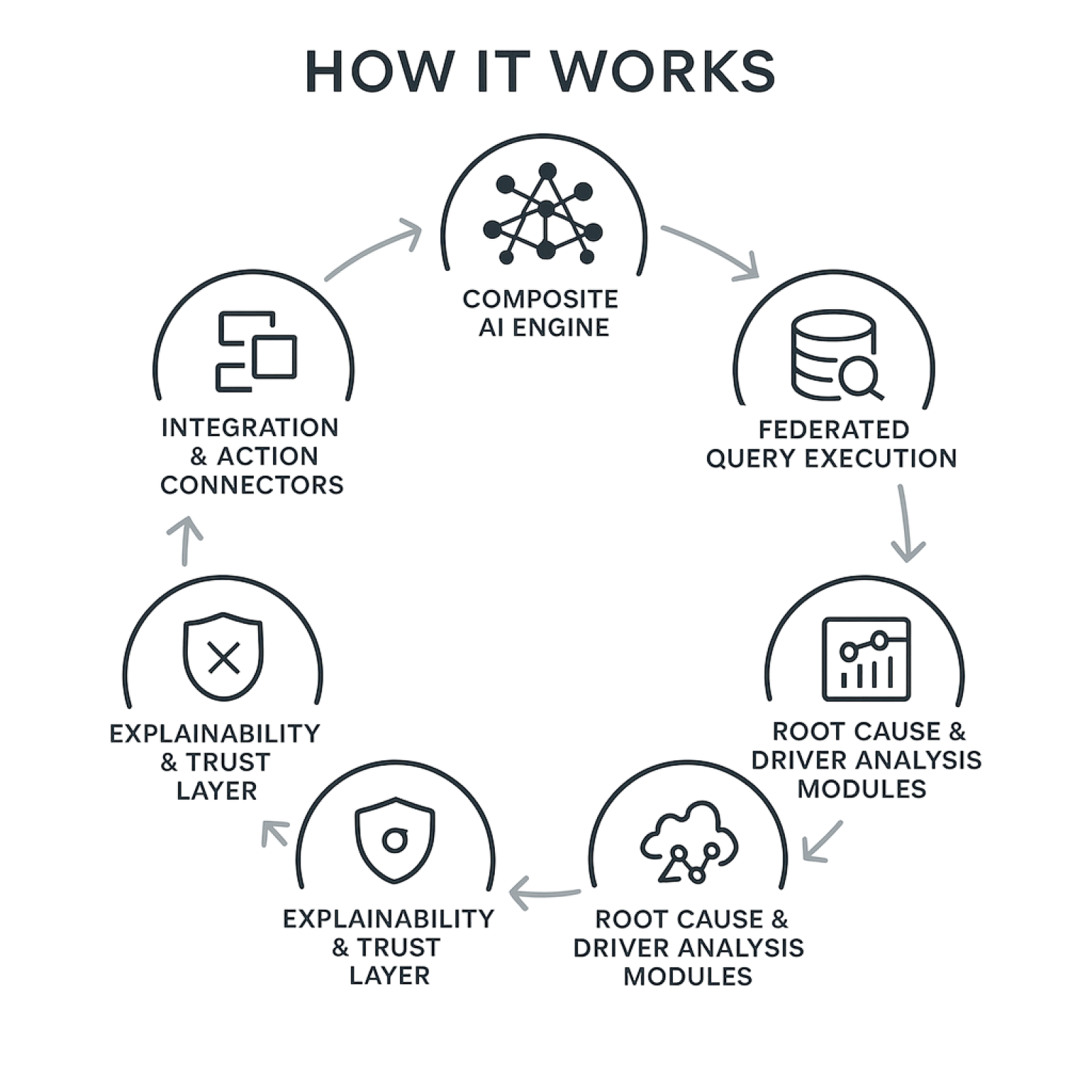Guided Insights, Evolved: How AI Agents Are Transforming the Way We Understand Data
%20(7).png)
For years, analytics platforms have promised to "guide" users to insights. But for many teams, guided insights still meant squinting at dashboards, wrestling with filters, and hoping for a tooltip that told a coherent story. The result? Missed opportunities, slow decision-making, and a mounting learning curve preventing organizations from making full use of their data.
That’s changing. A new generation of AI-powered analytics platforms is redefining what guided insights can be—and at the heart of this shift are AI Agents. These intelligent systems don’t just summarize data; they understand your question, analyze context, investigate root causes, and deliver clear, actionable answers. They also simplify advanced workflows, removing complexity without reducing analytical power.
In this post, we’ll explore how guided insights have evolved, why traditional approaches fall short, the technical underpinnings of agentic analytics, and how platforms like Tellius are making data understanding easier, faster, and more impactful for both business users and analysts.
What Are Guided Insights?
Guided insights automatically discover and explain trends, patterns, or anomalies in your data, unlocking and expediting valuable diagnostic analysis to all. Historically, this meant static summaries triggered by predefined rules. These helped reduce interpretation burden but rarely answered the deeper "why" or "what next."
Modern guided insights—especially those powered by AI agents—go further: they dynamically adapt to user questions, data changes, and business context, providing explanations, context, and suggested actions that lead directly to better decisions.
Unlike traditional BI features, these insights are conversational, context-aware, and iterative—meaning users can go deeper with follow-up questions without starting over. This shift empowers users to explore data in a natural flow, unlocking deeper, more nuanced answers without technical barriers.
.png)
The Problem with Traditional Guided Insights

Guided insights were a leap forward when they first entered the analytics landscape — helping business users move beyond static dashboards and manually built reports. But like any first-generation technology, their capabilities were shaped by the limitations of the time. They made analytics more accessible, but often couldn’t fully bridge the gap between data and decisive action, falling short in the following areas:
1. Limited insight depth
Traditional guided insights offered high-level explanations for changes to KPIs. But they did not go a step further like a human analyst might to segment changes by product line, region, customer type, or other drivers. This left users needing a deeper dive, often handing the baton back to analysts to investigate further.
2. Static, pre-defined logic and limited personalization
Earlier guided insight capabilities relied on preset rules or fixed queries and were divorced from the end users context. While these surfaced patterns, they weren’t designed to adjust dynamically to new business questions or fast-changing conditions. For example, a quarterly drop in sales might trigger the same high-level summary every time, even if the real drivers had shifted dramatically.
3. Limited connection to action
First generation guided insights capabilities had insights typically living inside dashboards or static reports. They provided valuable awareness but didn’t always connect seamlessly to downstream action — such as pushing segments into a CRM, adjusting territory alignments, or triggering a targeted campaign. Closing that gap required extra steps and handoffs.
4. Prone to interpretation errors
For business users without a technical background, interpreting even well-designed visual summaries could still feel daunting. Applying filters, selecting comparisons, and drawing the right conclusions often required support from someone more data-savvy, reducing the speed and independence that guided insights set out to provide.
5. Analyst time still in high demand
Because these insights didn’t always adapt in real time or drill deeply enough, analysts were still heavily involved in follow-up work to perform deeper root cause analysis, run scenario analyses, and create ad-hoc views. The value was real, but the process was still more reactive than proactive.
The takeaway:
Traditional guided insights marked an important milestone in analytics accessibility. They laid the groundwork for self-service, made data narratives more approachable, and helped shorten time to understanding. But the business world — and the data powering it — moves faster now. The next evolution is about insights that are not only descriptive, but adaptive, context-aware, and immediately actionable.
That’s where AI agents take guided insights to the next level.
AI Agents Enable Guided Insights to Think, Adapt, and Act
If traditional guided insights were the first step in making analytics more accessible, AI agents are the next leap forward — turning insight delivery into a proactive, adaptive, and conversational experience.
Rather than presenting a static observation, AI agents operate more like a collaborative partner in analysis. They:
- Surface the deeper “why”. Agentic guided insights don’t stop at telling you what changed with some high level explanations. They instead automatically segment the data to uncover which customers, regions, products, or external factors drove the change, layering insights to reveal the full story, while offering conversational follow-ons and suggested next questions and lines or inquiry to address the issue and interconnected issues.
- Dynamic, 2-way, contextually relevant insights. Rather than predefined approaches, agents dynamically determine how to approach the problem. They select the most relevant datasets, identify the right analytical techniques — from correlation analysis to anomaly detection — and even run multiple methods in parallel to validate findings. Then, based on semantic understanding, knowledge graph, user intent, role, past interactions, and relevant business context, they identify relevant findings and offer up next best actions and support iterative exploration conversations with AI agents so conversations don’t end with the first response. You can ask follow-up questions, pivot to related analyses, or explore alternative scenarios, all without starting from scratch.
- Interconnected and action-oriented
AI-powered guided insights are designed to be interconnected with systems to assist you in taking action. Instead of living in isolated dashboards or static reports, these insights are embedded directly into workflows. They go beyond providing awareness by seamlessly connecting to downstream actions, such as pushing segments into a CRM, adjusting territory alignments, or automatically triggering a targeted campaign. This tight integration eliminates extra steps and handoffs, allowing you to move from insight to action instantly. - Enhanced interpretation and understanding. Agentic guided insights make data and insights accessible to everyone, regardless of their technical background. Natural language processing (NLP) capabilities allow users to ask questions in plain English, such as "What were our top-selling products in Q2?" and receive a clear, conversational answer. This eliminates the need for users to manually apply filters or build complex comparisons. Furthermore, proactive, guided narratives can automatically highlight key findings and suggest next steps, ensuring that users not only see the data but also understand its implications and the conclusions they should be drawing.
- Proactively suggest next steps
Guided insights have always provided awareness; agents add foresight. They recommend actions aligned to business goals, highlight potential risks, and anticipate follow-up questions — so you can move from answer to decision faster.
This evolution represents a shift from descriptive, static summaries to adaptive, context-aware intelligence. It reduces the cognitive load for business users, frees analysts from repetitive follow-up requests, and ensures that every answer is as relevant and actionable as the moment demands.
With Tellius AI agents, guided insights aren’t just about finding patterns in your data — they’re about understanding them in context, acting on them in real time, and continually refining the path from curiosity to confident decision.
Under the Hood: How AI Agents Work

Here’s how Agentic guided insights work:
1. Natural Language Understanding (NLU)
It starts the moment you type or speak a question. The agent breaks your query down into its essential components — intent (what you want to know), entities (products, regions, customers), metrics (TRx, revenue, churn), filters (timeframe, geography), and the desired outcome (root cause, forecast, comparison).
- This step bridges how humans think with how data is stored.
- Advanced synonym recognition and role-aware understanding ensure the agent interprets “orders” the same as “sales,” or knows when “my accounts” means “accounts in your territory.”
2. Governed Semantic Layer Mapping
The agent then translates your request into the business’s shared language — pulling metric definitions, hierarchies, and access permissions from a governed semantic layer.
- This ensures “revenue” in marketing means the same thing as “revenue” in finance.
- Security rules mean users only see the data they’re allowed to see, no matter how they phrase the question.
3. Analytical Path Planning & Orchestration
Unlike static queries, AI agents plan an optimal route to the answer in real time. The orchestration engine:
- Chooses which analysis modules to activate (root cause, anomaly detection, driver analysis, prediction).
- Determines sequencing — for example, running a high-level variance check before diving into segment-level correlations.
- Can run multiple analyses in parallel and reconcile the results into a single, coherent narrative.
4. Federated Query Execution
Tellius agents push as much of the heavy lifting as possible down to your data sources — whether that’s Snowflake, Databricks, Redshift, or others.
- This eliminates unnecessary data movement, speeds performance, and keeps sensitive data within your governance boundaries.
- Queries are optimized for scale, so agents can handle billions of rows without grinding to a halt.
5. Composite AI Processing
This is where statistical models, machine learning algorithms, and business rules come together.
- The agent may use regression analysis to identify correlations, clustering to find meaningful groupings, or time-series forecasting to predict trends.
- It doesn’t blindly pick one technique — it chooses based on the question, the shape of the data, and the confidence needed.
6. Narrative & Action Layer
Once the analysis is complete, the agent doesn’t just drop a table or chart. It tells the story:
- A concise, plain-language explanation of what happened and why.
- Visualizations to illustrate patterns and drivers.
- Clear, relevant next steps you can take immediately.
- Optional one-click actions, like exporting a target segment to a CRM or triggering a follow-up alert.
7. Explainability & Trust Framework
Finally, every insight comes with a “why you should trust this” trail.
- Users can see the underlying data, the analytical steps taken, and any assumptions made.
- Confidence scores and version histories are logged for auditability.
- Analysts can replicate, validate, or expand the analysis without losing context.
The end result:
Business users get answers in seconds that they can understand and act on. Analysts can trust and build upon those results without redoing the work. Leaders can make decisions knowing both the “what” and the “why” — all in the moment it matters most.
Technical Deep Dive: Core Components That Power Agentic Guided Insights
AI agents don’t operate in isolation — they’re built on a foundation of integrated components that balance intelligence, governance, and scale. In Tellius, these components work together seamlessly to take an insight from question to action.

1. Composite AI Engine
The heart of the Tellius platform is a composite AI engine that blends multiple analytical approaches:
- Statistical Models for precision and explainability (e.g., variance analysis, correlation coefficients, regression models).
- Machine Learning Algorithms for pattern detection and predictive power (e.g., clustering, classification, time-series forecasting).
- Business Rule Logic to enforce domain-specific constraints, KPIs, and decision thresholds.
This adaptive selection process ensures that every analysis uses the right tool for the job, not a one-size-fits-all method.
2. Governed Semantic Layer
All analysis runs through a governed semantic layer that enforces business definitions, hierarchies, and security rules:
- Metric consistency across teams and departments.
- Role-based data access that ensures compliance.
- Support for synonyms and natural language aliases to make querying feel natural while still mapping to trusted definitions.
3. Federated Query Execution
Rather than moving data into Tellius, the platform pushes queries down to where the data lives — Snowflake, Databricks, Redshift, BigQuery, and beyond.
- Minimizes latency and risk by avoiding data duplication.
- Optimizes performance with pushdown filters, aggregations, and joins that execute directly at the source.
Scales seamlessly from millions to billions of rows without choking performance.
4. Orchestration & Workflow Layer
This is the agent’s “air traffic control” — the layer that decides how to run the right analyses in the right order:
- Dynamically sequences workflows based on the question type, data shape, and performance needs.
- Runs multiple analytical modules in parallel when possible to accelerate answers.
- Allows chaining of insights into broader narratives — e.g., moving from a sales decline analysis to a customer segment deep dive, then to campaign targeting recommendations without starting over.
5. Insight Graph + Context Memory
A persistent context layer stores the relationships between users, metrics, datasets, and prior analyses:
- Agents can “remember” what’s been asked and build on it.
- Historical context helps detect patterns over time (e.g., recurring seasonal dips, anomalies that repeat under specific conditions).
- Supports multi-turn conversations where the agent refines its focus based on your feedback.
6. Root Cause & Driver Analysis Modules
Purpose-built analytical modules pinpoint the “why” behind metric changes:
- Automatically segments data across relevant dimensions (e.g., geography, channel, customer type).
- Calculates contribution scores to identify the most impactful drivers.
- Flags correlations and anomalies that might otherwise be missed in manual exploration.
7. Explainability & Trust Layer
Transparency is baked in from the start:
- Every step of the analysis is logged and reproducible.
- Confidence scores help users assess reliability.
- Analysts can drill into the methodology, see exactly which models were used, and validate or extend the findings.
8. Integration & Action Connectors
Insights don’t just live inside Tellius — they flow into your operational systems:
- Export audience lists to CRM or marketing automation platforms.
- Push alerts to Slack, Teams, or email when key metrics change.
- Trigger follow-up workflows in tools like Salesforce, HubSpot, or custom APIs.
This closes the loop from insight to action without manual copy-paste or time-consuming handoffs.
Real-World Examples: Guided Insights in Action
The power of Tellius AI agents isn’t abstract — it’s in how they solve real problems across industries, day after day. Each of the following scenarios shows the end-to-end journey from question to confident decision, and how the underlying platform components work together in the background.
Commercial Pharma: Diagnosing a Sales Dip with Surgical Precision
The question: “Why did TRx for Brand A drop in Q2?”
The challenge: In a highly competitive therapeutic category, even a small dip in prescriptions can signal significant shifts — formulary changes, competitor launches, or marketing execution gaps.
What the AI agent does:
- NLU + Semantic Mapping interprets “TRx” and “Brand A” in the context of pharma data models, mapping to the correct claims data and brand hierarchy.
- Federated Query Execution pulls aggregated metrics directly from a Snowflake warehouse containing billions of anonymized claims.
- Root Cause Analysis Module segments the dip by prescriber decile, specialty, and geography.
- Insight Graph links the timing of the drop to a formulary exclusion event detected in payer data.
- Narrative & Action Layer explains that the largest impact came from PCPs in Texas and Florida, and automatically generates a target list of unaffected high-decile HCPs.
- Action Connectors push that list directly into the CRM for immediate field follow-up.
The outcome: Days of manual analysis compressed into minutes, field reps targeting the right HCPs by the end of the day, and market access teams alerted in time to counter competitive gains.
CPG: Maximizing ROI on Promotions
The question: “Which customer segments responded best to our summer promotion?”
The challenge: Promotions are expensive — and without precise measurement, brands risk spending more to reach customers than those customers spend in return.
What the AI agent does:
- NLU interprets “summer promotion” to link loyalty transaction data, campaign spend, and promotional calendar.
- Federated Query Execution joins POS data from a Databricks lakehouse with campaign records in Google BigQuery.
- Composite AI Processing uses uplift modeling to measure incremental sales lift by segment.
- Root Cause & Driver Modules surface that suburban households with children drove the largest ROI, while urban singles underperformed.
- Narrative & Action Layer delivers a clear recommendation: shift next quarter’s budget toward the high-performing segment and reduce spend in the low-performing one.
- Integration Connectors send the optimized segment to the activation platform for immediate targeting.
The outcome: Marketing and category teams adjust campaign spend allocation in real time, boosting ROI and preventing wasted spend.
FP&A: Controlling Budget Overruns Before They Snowball
The question: “Why are expenses over budget in Q3?”
The challenge: By the time a budget overrun shows up in quarterly reports, it’s often too late to prevent the impact on margins — unless you can pinpoint the cause quickly and accurately.
What the AI agent does:
- Semantic Layer Mapping aligns “expenses” with the correct GL codes across regions and departments.
- Federated Query Execution pulls cost data from Redshift and correlates it with external commodity price feeds.
- Root Cause Analysis identifies raw material price spikes in two manufacturing plants as the largest driver of variance.
- Orchestration Layer triggers scenario modeling to forecast Q4 costs under different sourcing strategies.
- Narrative & Action Layer presents two actionable scenarios: negotiate supplier contracts now or shift production to plants in lower-cost regions.
The outcome: Leadership acts before Q4 spend locks in, avoiding a seven-figure impact to EBITDA.
Healthcare Provider Network: Closing the Post-Discharge Gap
The question: “Where are patient outcomes lagging post-discharge?”
The challenge: Readmission rates are a critical quality and financial metric. Identifying at-risk populations quickly can prevent both patient harm and revenue penalties.
What the AI agent does:
- NLU + Semantic Mapping links “post-discharge” to EMR and care management datasets, filtered for readmission metrics.
- Federated Query Execution aggregates clinical data from multiple on-premises systems without moving sensitive PHI.
- Driver Analysis Modules reveal that rural patients without telehealth follow-up have a 20% higher readmission rate.
- Insight Graph connects this to staffing records, showing a shortage of follow-up nurse coverage in those regions.
- Narrative & Action Layer recommends expanding telehealth outreach and reallocating nurse resources, projecting a potential 15% reduction in readmissions.
The outcome: Care teams implement the plan within weeks, improving patient outcomes and avoiding penalties under value-based care contracts.
The common thread: In every example, the Tellius AI agent doesn’t just answer a question — it orchestrates the right data, the right analyses, and the right actions in one continuous flow. Business users get clarity without wading through dashboards, analysts spend more time on strategic work, and the organization moves from reaction to readiness.
Addressing the Learning Curve: Simpler, Smarter, Faster
One of the biggest reasons analytics projects stall isn’t the technology — it’s adoption. Even with modern BI tools, two persistent realities have held organizations back:
1. Business users often feel overwhelmed.
Non-technical users face a steep learning curve with traditional tools. They must know which dashboard contains the answer, how to apply the right filters, and how to interpret the visuals. The fear of “doing it wrong” can be enough to stop them from even trying. The result is dependency — they default back to emailing an analyst for answers.
2. Analysts spend too much time on low-leverage work.
Because guided insights and dashboards can’t always anticipate every nuance of a question, analysts get pulled into a constant stream of ad-hoc requests. These often repeat, just in slightly different forms: “Can you break this down by region?” … “What about just my accounts?” … “Can you show me last year’s numbers too?” This cycle erodes their ability to focus on high-impact, strategic analysis.
How AI Agents Change the Equation
Tellius AI agents flatten the learning curve by removing the friction between question and answer for business users and analysts.
The Net Impact
When the learning curve flattens for business users and the interruption cycle breaks for analysts, analytics becomes both more democratic and more impactful:
- More people asking better questions.
- More high-quality answers delivered in real time.
- More analyst bandwidth for innovation.
- A shorter, smoother path from insight to action.
Conclusion: The Future of Guided Insights Is Agentic
Guided insights changed the analytics game when they first emerged — breaking through the static dashboards and rigid reporting cycles that slowed decision-making for decades. They made data more approachable, more visual, and more widely consumed. But business moves faster now. Data is more complex, decisions are more interconnected, and the gap between insight and action has never been more costly.
AI agents are the natural evolution. They build on the strengths of guided insights, but go further — adapting to your questions in real time, uncovering the “why” without extra effort, and surfacing actions you can take immediately. They bring together the best of automation, machine learning, and conversational analytics into one continuous flow from curiosity to confident decision.
With Tellius, this evolution is not theoretical — it’s here, and it’s enterprise-ready. The platform’s AI agents operate on your live data, respect your governance, and deliver insights with the speed, depth, and clarity today’s business leaders demand. For business users, it means answers without barriers. For analysts, it means time to focus on what matters most. For the organization, it means moving from reactive reporting to proactive decision-making.
The next era of analytics won’t be defined by how many dashboards you have — it will be defined by how quickly, confidently, and consistently you can turn questions into action. With Tellius AI agents powering guided insights, that future is within reach today.
Ready to experience the evolution?
Ask your first question. See how far the right answer can take you.
Learn more about Tellius Guided Insights
Get release updates delivered straight to your inbox.
No spam—we hate it as much as you do!

%20(3).jpg)
Will AI Replace Analysts? The Evolving Nature of the Role in the Agentic Era

As AI agents take over routine data tasks, the traditional analyst role isn’t disappearing—it’s evolving. In the “agentic era,” analysts transition from data cleaners and report builders into orchestrators who guide AI workflows, interpret results, and embed insights into business decisions. This blog explains the mechanics of agentic analytics, explores how AI handles repetitive work, and defines the new skills needed—like prompt engineering, bias review, and ethical oversight—to thrive alongside autonomous systems.
.png)
AI Analytics & Agentic AI: Definition, Benefits, and Real-World Examples

This 2025 guide to AI analytics covers definition, architecture, and examples—plus how agentic AI with a semantic layer and orchestrated AI agents turns insights into approved action, reducing time-to-action and delivering measurable impact.


